The Renaissance period, spanning from the 14th to the 17th century, marked a significant cultural, artistic, and intellectual rebirth in Europe. This era remains renowned for its innovative and inspiring contributions to the fields of philosophy, literature, and art, and it greatly influenced the evolution of fashion. Distinct clothing regulations and styles delineated social classes, with the choice of attire reflecting one’s status. From practical garments worn by the lower classes to lavish materials, such as silk and velvet, donned by the upper classes, fashion played a pivotal role in defining social hierarchy.
Women’s clothing during this era was both intricate and diverse, with varying styles in vogue each year. Gowns consisted of a form-fitting bodice and a fuller ankle-length skirt, while elaborate, low-cut necklines for the upper class added an air of sophistication. As opposed to the heavier, bulkier garments worn by wealthier women, those of lesser means opted for more functional attire that allowed for greater mobility. Regardless of social standing, garments like shifts, petticoats, and stockings formed the base layers of all outfits. The rich tapestry of Renaissance fashion offers an array of stunning costumes, making it an enchanting stylistic choice for parties and events.
Countess Dress

In our exploration of Renaissance outfits, we must take a moment to appreciate the elegance and grandeur of the Countess Dress. These dresses were frequently worn by noblewomen during the Renaissance period, and they showcased the wearer’s high social standing.
The Countess Dress typically featured luxurious materials such as silk, brocade, velvet, and lace. Intricate details, like embroidery and beading, would often adorn the gown, emphasizing the wearer’s wealth and status. Let’s take a look at some key attributes of these beautiful gowns:
- Bodice: The bodice of a Countess Dress was tightly fitted, often with boning to accentuate the wearer’s waist. The combination of a tight bodice and a full skirt created a flattering silhouette that was popular throughout the Renaissance period.
- Sleeves: The sleeves of a Countess Dress were typically long and flowing, many times with lace or embroidered cuffs. In some cases, the sleeves were detachable, allowing the wearer to change their look without needing an entirely new gown.
- Skirt: The skirt of a Countess Dress was voluminous, often supported by a farthingale, a hoop skirt that created the desired fullness from the waist down. Layers of petticoats were also used to achieve the desired shape and volume.
- Neckline: The neckline of a Countess Dress could vary from high and modest to low and plunging, depending on the wearer’s preference and the specific trends of the time. Decorative collars were common, adding an extra touch of elegance to the overall design.
It is important to remember that not only noblewomen donned such beautiful garments, as variations of the Countess Dress could be found in the wardrobes of both middle and lower class women. Of course, the materials and embellishments would be less extravagant, but the general silhouette and style would remain reminiscent of their higher-class counterparts.
Renaissance dresses, including the Countess Dress, were not only exclusive to the Renaissance period, as medieval dresses shared some similar characteristics. Both periods featured the use of luxurious materials, tight-fitting bodices, and voluminous skirts, showing a connection between the two eras in terms of fashion.
Hearthkeeper Set
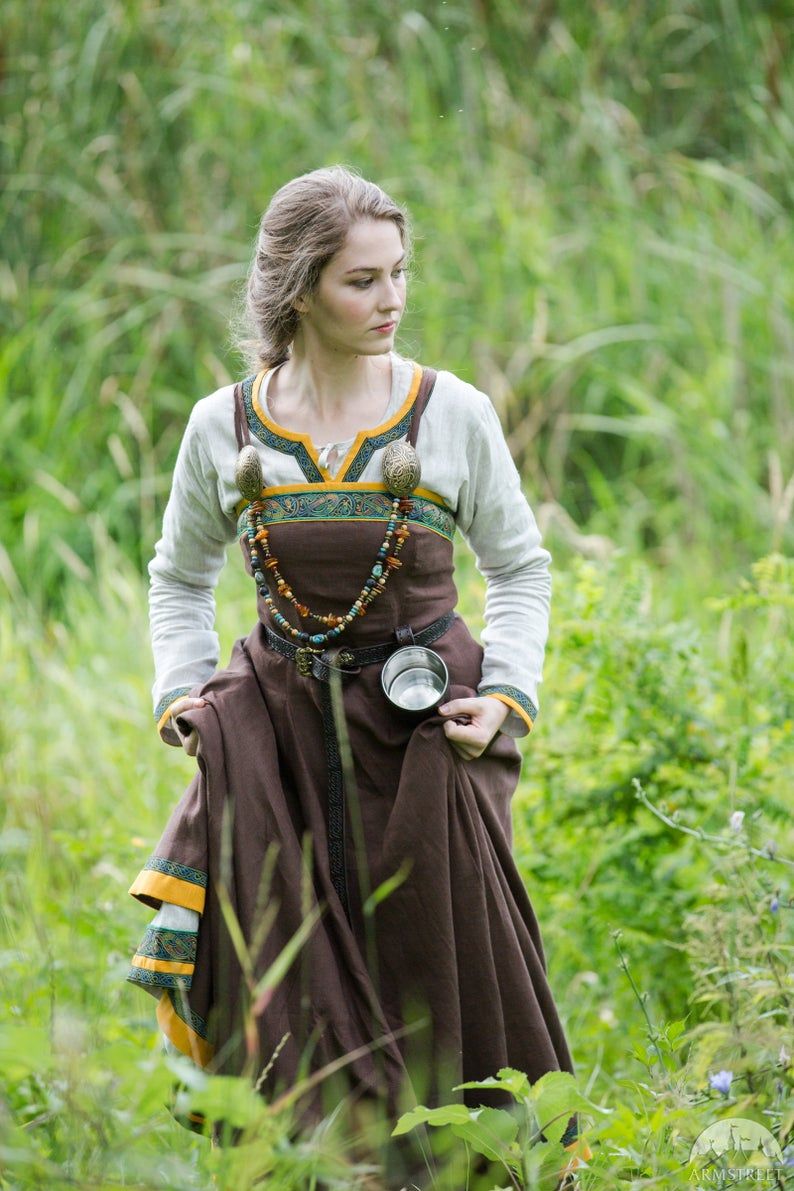
As part of Renaissance outfits, we can admire the simple yet essential Hearthkeeper Set, commonly worn by peasants during that period. With a focus on functionality and affordability, this set was designed to fulfill the needs of those working on farms and in households.
Components of the Hearthkeeper Set:
- Tunic: A loose, long-sleeved garment made from coarse linen or wool to provide comfort during long hours of work.
- Breeches: Knee-length trousers, also made from coarse linen or wool, that provide mobility for the lower body.
- Apron: Worn by both men and women to protect their clothing during work, these were made from sturdy, easily washable fabrics like linen.
- Coif: A simple head covering, typically made from linen, that protected the wearer’s hair from dirt and helped maintain modesty.
- Stockings: Knitted or woven from wool or linen to cover the legs and feet, often worn with simple leather shoes or boots.
- Accessories: Belts, pouches, and simple tools might also be worn as part of the Hearthkeeper Set to facilitate work and carry essential items.
In summary, the Hearthkeeper Set provided a practical and economical clothing solution for peasants during the Renaissance period while also reflecting the social order and modesty of the time.
Borgia Sleeveless Dress

During the Renaissance period, notable outfits caught the eye of all, especially within the realm of nobility. One iconic piece of attire to consider is the Borgia Sleeveless Dress. Made popular by the powerful Borgia family, the dress represents wealth and prominence, widely worn by noblewomen of the time.
The Borgia Sleeveless Dress featured:
- Luxurious fabrics, including velvet, satin, and brocade
- Delicate embroidery work to showcase wealth and status
- A square neckline, common among Renaissance fashion
- A close-fitting bodice, emphasizing the silhouette of the wearer
- A full-length skirt, often layered or adorned with intricate designs
As we explore the realm of Renaissance attire, it’s essential to appreciate the influence the Borgia Sleeveless Dress had among nobility, as it remains a symbol of elegance, power, and extravagance from this fascinating era in history.
Elven Dress
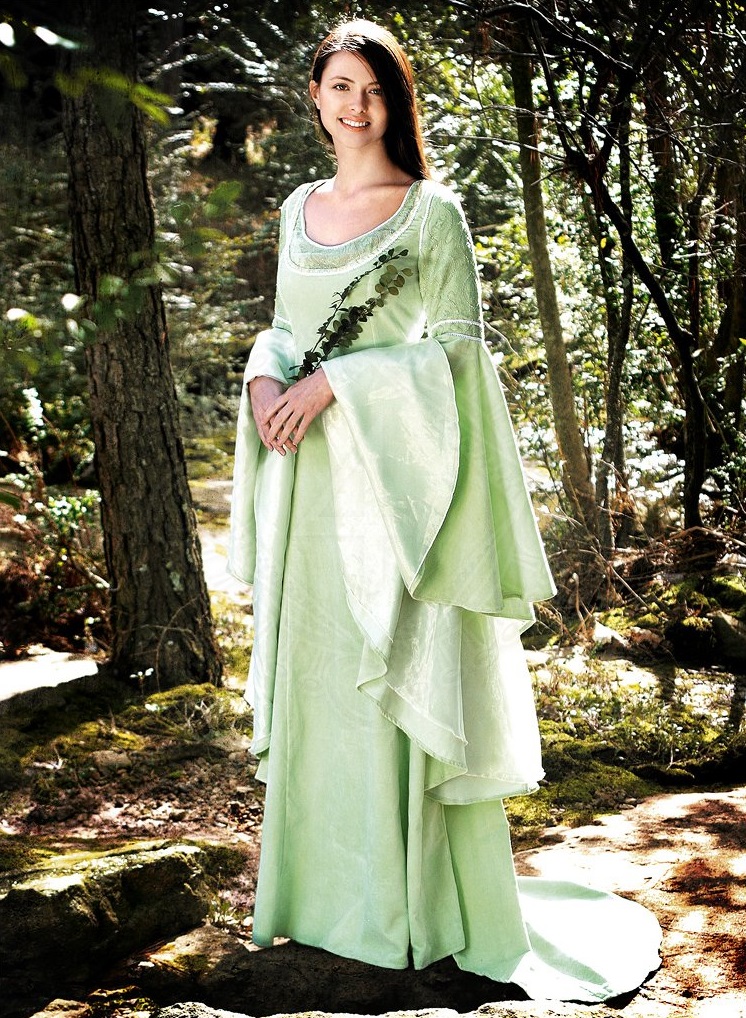
In our exploration of Renaissance outfits, we cannot skip the captivating Elven dress. Rooted in the world of fantasy and inspired by nature, these elegant dresses often combine Renaissance fashion influences with a touch of whimsy and magic.
The base layer of the Elven dress is typically a chemise, a loose-fitting long garment made from light, breathable materials like linen or cotton. This serves as the foundation for the various elements of the dress, including:
- A fitted bodice, often with intricate embroidery or lace.
- Long, flowy sleeves, sometimes with split or wide-cuff designs.
- A full, floor-length skirt gathered at the waist, sometimes with layers or panels for added volume.
Other noteworthy features of an Elven dress:
- Natural colors like greens, browns, and blues are often chosen to reflect the connection with nature and enhance the ethereal look.
- Earthy and organic patterns such as floral embroidery and delicate, flowing lines can adorn the dress, connecting it to the enchanted forest setting often associated with elves.
- Accessories like metal circlets, floral crowns, or delicate jewelry emphasize the mystical and regal nature of elves.
As we delve deeper into the realm of Renaissance outfits, we can appreciate the timeless charm of the Elven dress and its enchanting blend of historical inspiration and imaginative flair.
Red Velvet Dress
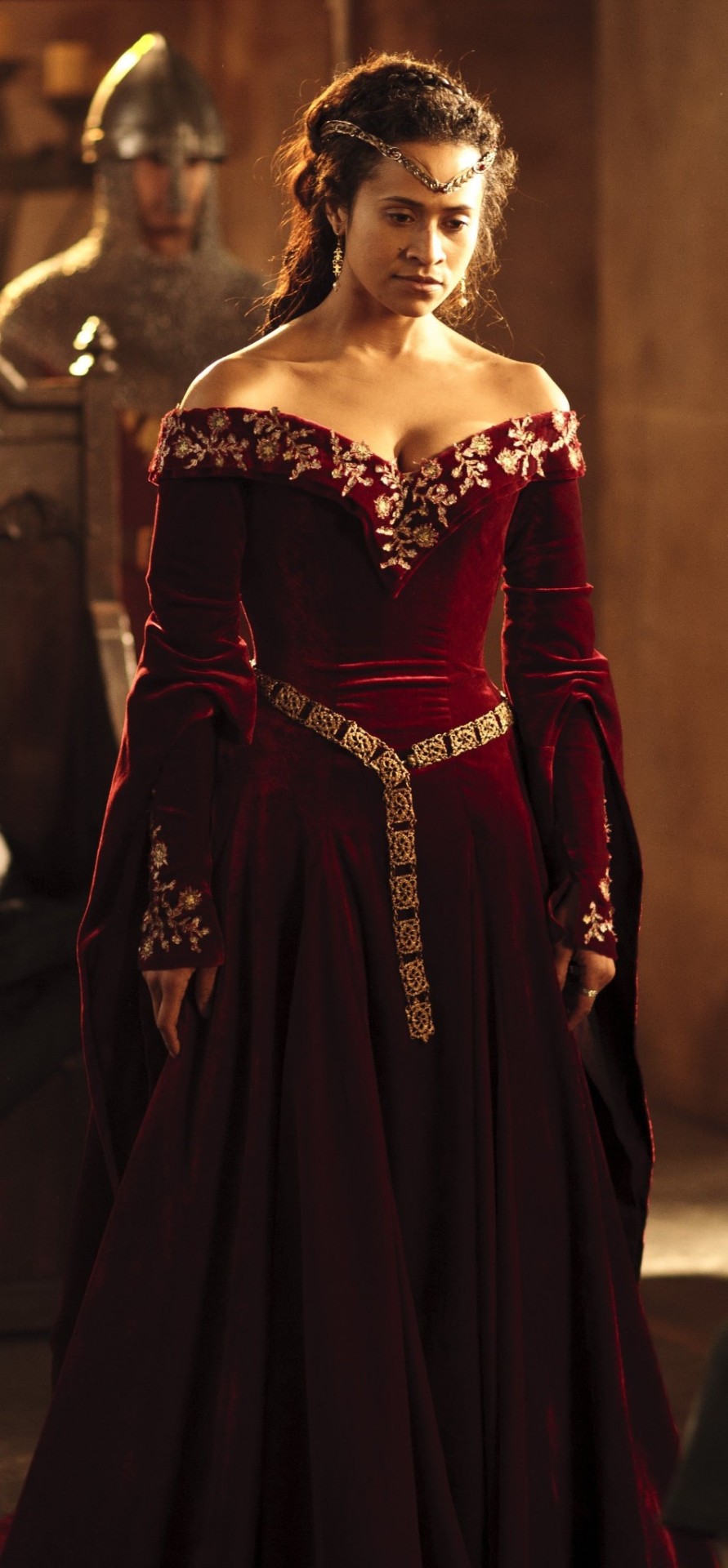
In Renaissance times, a red velvet dress held a special place in fashion, signifying wealth and status. This luxurious fabric, often made from silk, was prized for its softness and rich color. Let’s explore some distinctive features of a typical red velvet dress from this era.
- Bold Color: The deep red hue of the velvet dress was a symbol of power, and only the most affluent could afford this rare and costly pigment.
- High Necklines: Red velvet dresses often had high necklines, reflecting the modesty and refinement of the Renaissance period.
- Puffy Sleeves: To display the richness of the fabric, the dresses often featured puffy sleeves, which were both fashionable and functional, keeping the wearer warm in colder months.
- Embroidery and Trim: Intricate embroidery and trimming gave the red velvet dress an even greater sense of luxury and opulence. Gold and silver threads were commonly used to create eye-catching patterns on the dress.
- Supportive Bodice: The bodice of a red velvet dress provides support to the upper body, enhancing the natural shape of the wearer. It was typically stiffened with materials such as whalebone and laced up at the back to ensure a snug fit.
- Full Skirts: The full skirts of these dresses were designed to create an elegant silhouette and often featured multiple layers in order to accentuate the luxuriousness of the velvet fabric.
In conclusion, the red velvet dress was a symbol of elegance and prestige during the Renaissance era. With its rich color, opulent embellishments, and intricate designs, it served as a fashionable and functional part of the wardrobe for the upper class.
Tudor Gown
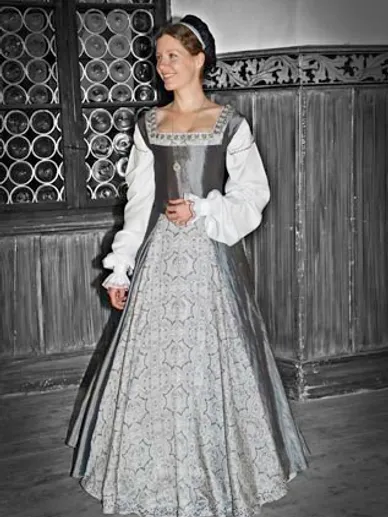
In our exploration of Renaissance outfits, we now turn our attention to the Tudor gowns, marvelously elaborate dresses often worn for special occasions such as weddings. The Tudor gown was characterized by its fitted bodice, long sleeves, and floor-length full skirt, which showcased intricate embroidery and fine detailing.
For a medieval wedding, wearing a Tudor gown would signify wealth, nobility, and fashion sense. The Tudor wedding gown typically featured:
- Rich fabrics: Luxurious materials such as satin, velvet, and silk were the preferred choices for these gowns.
- Elaborate embroidery: Intricate patterns and designs adorned the fabric, often in the form of flowers, foliage, or symbols of love and loyalty.
- Jewel embellishments: Pearls, gemstones, and gold threads were often used to further enhance the gown’s opulence.
- Long sleeves: These sleeves could be fitted or wide, sometimes featuring decorative cuffs, and were often detachable for versatility.
- Padded skirts: A stiff petticoat or farthingale would be worn underneath the skirt, giving it structure and volume.
In our quest to understand Renaissance fashion, the Tudor gown stands as an exquisite example of the era’s artistry and craftsmanship, particularly in relation to wedding attire and special occasions.
Burgundian Gown
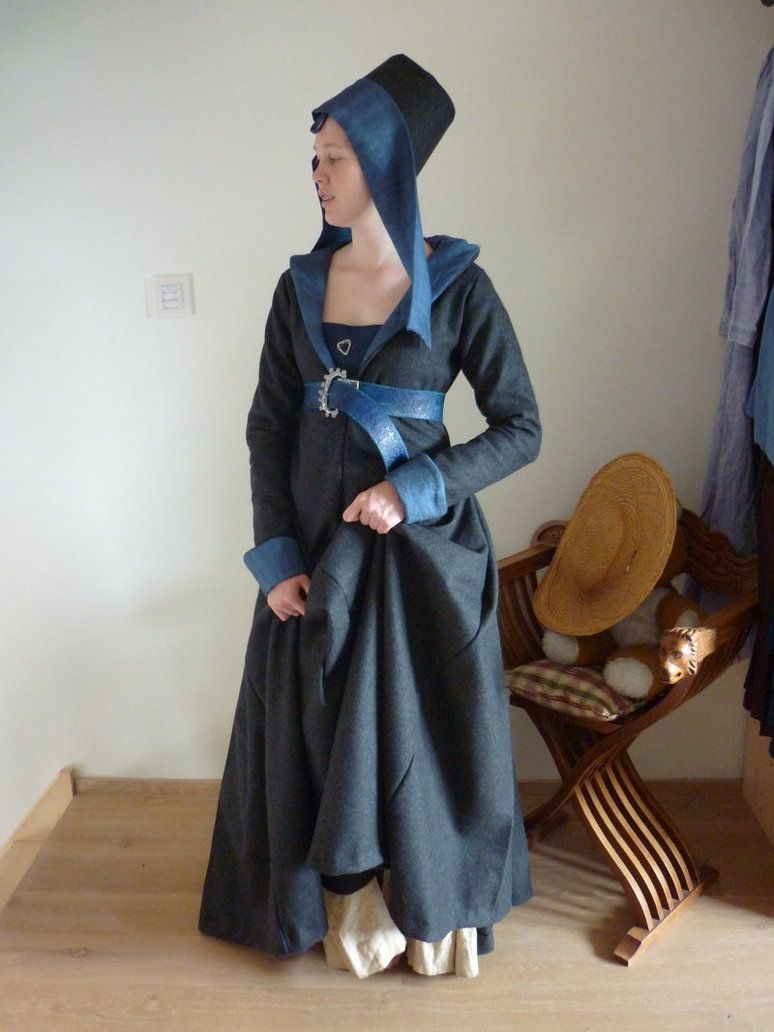
As we dive deeper into the fascinating world of Renaissance outfits, let us take a closer look at the Burgundian Gown. This garment was predominantly worn by the upper class during the 15th century in the region of Burgundy, which was then an important cultural and political center in Europe. The Burgundian Gown is considered an iconic symbol of luxury and wealth.
The gown features several distinctive components:
- V-neckline: The low V-shape was both elegant and showed off the wearer’s status, as the fine fabrics and elaborate embroidery around the collar and neckline drew attention.
- Fur-lined houppelande: The outer layer of the gown, known as a houppelande, was characterized by its rich, heavy fabrics and fur trim, making it a luxurious and expensive piece of clothing. It often had wide, floor-length sleeves, signifying the wearer’s wealth and position.
- Kirtle underneath: Worn beneath the houppelande was a fitted, full-length garment called a kirtle. It was usually made from fine fabrics like silk or brocade to match the houppelande.
- Headwear: Women would typically wear elegant headdresses, such as hennins (tall, conical hats with veils) or elaborate headpieces adorned with jewels. Men would wear chaperons (a type of hat made from a long piece of fabric wrapped around the head).
- Accessories: Jewelry was commonly used to accentuate the Burgundian Gown: necklaces, brooches, belts, and rings were all popular choices. Fine fabrics, like velvet, were used in the design of these accessories to convey the wealth and social status of the wearer.
By examining this iconic piece of clothing, we can truly appreciate the role of fashion in the Renaissance period, reflecting the opulence and grandeur of its time.
Black & Green Gown

During the Renaissance period, we often encountered luxurious and elegant outfits that showcased the social status and wealth of the wearer. One such outfit was the Black & Green Gown, adorned with intricate patterns and designs.
The gown itself was typically made of high-quality materials such as silk and velvet, reflecting the opulence of the time. The combination of black and green colors was particularly striking, exuding a sense of sophistication and extravagance. Embellishments like lace, embroidery, and gems were often added to further enhance the gown’s elegance.
An essential accessory for this ensemble was the cloak. Cloaks were an integral part of Renaissance fashion, providing both warmth and a sense of refinement. They could be found in various lengths and styles, often made from luxurious materials like fur and brocade. For the black and green gown, the cloak would be made from a complementary fabric, with matching embroidery and details.
In summary, the Black & Green Gown represents the pinnacle of Renaissance fashion, showcasing the wealth, taste, and social standing of the wearer. Paired with a beautifully designed cloak, this outfit remains a symbol of opulence and elegance during one of history’s most artistically influential periods.
Red Lady
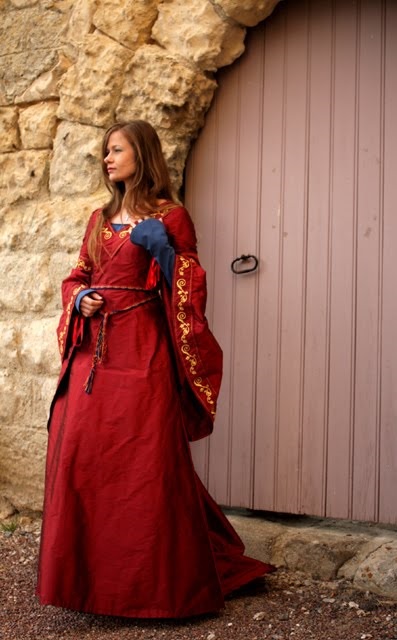
During the Renaissance, we saw a rich and diverse array of clothing styles, one of which was the “Red Lady” outfit. This one stands out for various reasons: the alluring color, its association with specific social standings, and intricate detailing.
The “Red Lady” outfit was often worn by ladies of nobility and wealth, setting them apart from the lower-class women during the Renaissance period. Here are some notable features of this outfit:
- Materials: High-quality materials, such as silk, velvet, and brocade were commonly used to make these dresses. These fabrics conveyed class and status to those who wore them.
- Color: Red, as the name suggests, was the most prominent color of this attire. This color was not only vivid and attractive but also symbolized power, passion, and nobility.
- Embroidery: To embellish the outfit, elaborate embroidery featuring gold and silver threads was often used. This intricate detailing would further elevate the elegance and sophistication of the attire.
- Accessories: Women wearing “Red Lady” outfits would also don luxurious accessories such as jeweled necklaces, pearl earrings, and ornate headdresses. These items would complement their opulent ensemble, showcasing their wealth and status.
In conclusion, the “Red Lady” outfit is a magnificent example of a high-class wardrobe staple during the Renaissance era. Its rich color, luxurious materials, and intricate details contributed to making this attire a symbol of nobility and wealth.
Princess Dress
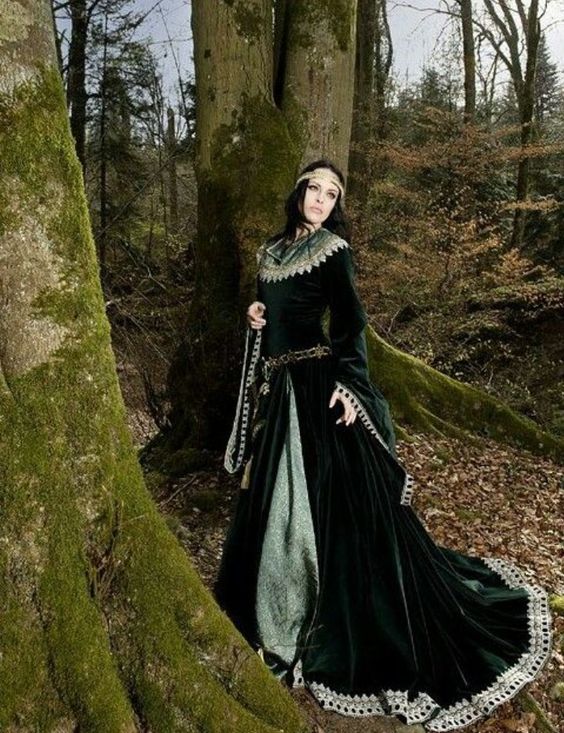
During the Renaissance period, princess dresses were an essential part of the aristocratic wardrobe. These dresses expressed wealth and status, and often featured luxurious materials. As part of a typical princess dress, shirts played an important role in completing the look. We will now explore the key characteristics of a princess dress, focusing on the role shirts have in this elegant attire.
- Materials: High-quality fabrics adorned with delicate lace or embroidery were commonly used for shirts. Silk, linen, and velvet were popular choices for the other parts of the dress, such as the gown, sleeves, and overskirt.
- Structure: Princess dresses typically had a fitted bodice accompanied by full-length skirts with multiple layers. The shirt, worn underneath the outer gown, provided extra coverage while adding a touch of elegance to the overall look.
- Shirt Features: Shirts usually consisted of a high neckline, with ruffles or lace at the collar. These intricate collars often framed the face and extended beyond the shoulders. They had long sleeves fitted at the wrist, adorned with lace or embellishments.
- Colors: The colors of a princess dress were mostly chosen based on the wearer’s rank and the occasion. Shirts were often white or in a more neutral color to avoid clashing and showcase the elegance of the detailed collar. The outer layers of the dress could be in brighter, more vivid colors.
To summarize, shirts played a crucial role in the aesthetics of Renaissance princess dresses, providing a polished and sophisticated finish. These garments showcased the wearer’s status and fashion prowess through the selection of fine materials, intricate details, and refined structure.
Aslaug Tunic
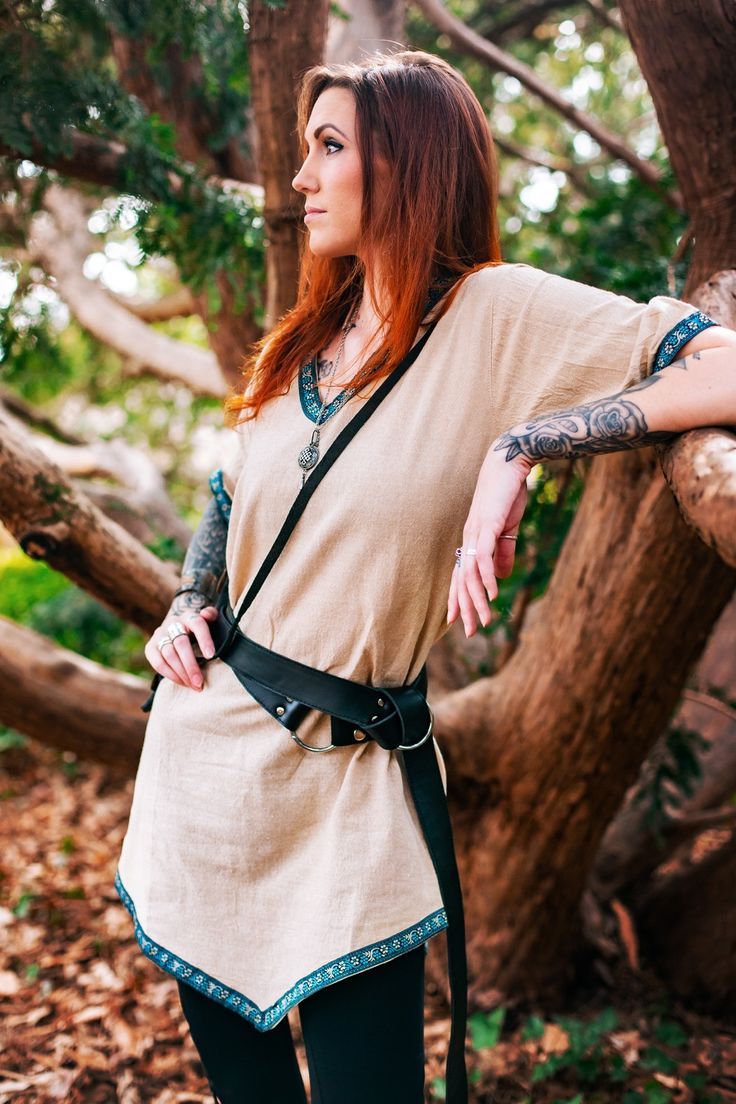
We find the Aslaug Tunic to be a wonderful representation of Renaissance outfits. Often paired with bodices or corsets, these tunics played an essential role in the fashion of the era. Tunics were a staple garment for both men and women, serving as a versatile piece that could be worn for various occasions.
Features of the Aslaug Tunic:
- Made from high-quality fabrics like silk, linen, or wool, ensuring comfort and durability
- Embellishments such as embroidery, lace, or brocade, added a touch of elegance and style to the garment
- Long, flowing sleeves that allowed for freedom of movement, especially when worn in conjunction with a bodice or corset.
Popular Pairings:
- Bodices: These provided extra support and shaping for the upper body. The combination of the Aslaug Tunic and a fitted bodice created a flattering silhouette that was characteristic of the Renaissance period.
- Corsets: Worn to emphasize the waist and create an hourglass figure, corsets were an essential component of Renaissance attire. Paired with an Aslaug Tunic, it offered an ideal balance of style and functionality.
In the Renaissance era, the Aslaug Tunic, along with other clothing items like bodices and corsets, showcased the unique styles and craftsmanship of the time. These garments continue to inspire modern-day fashion and provide a glimpse into the rich history of fashion and culture.
Archer Outfit
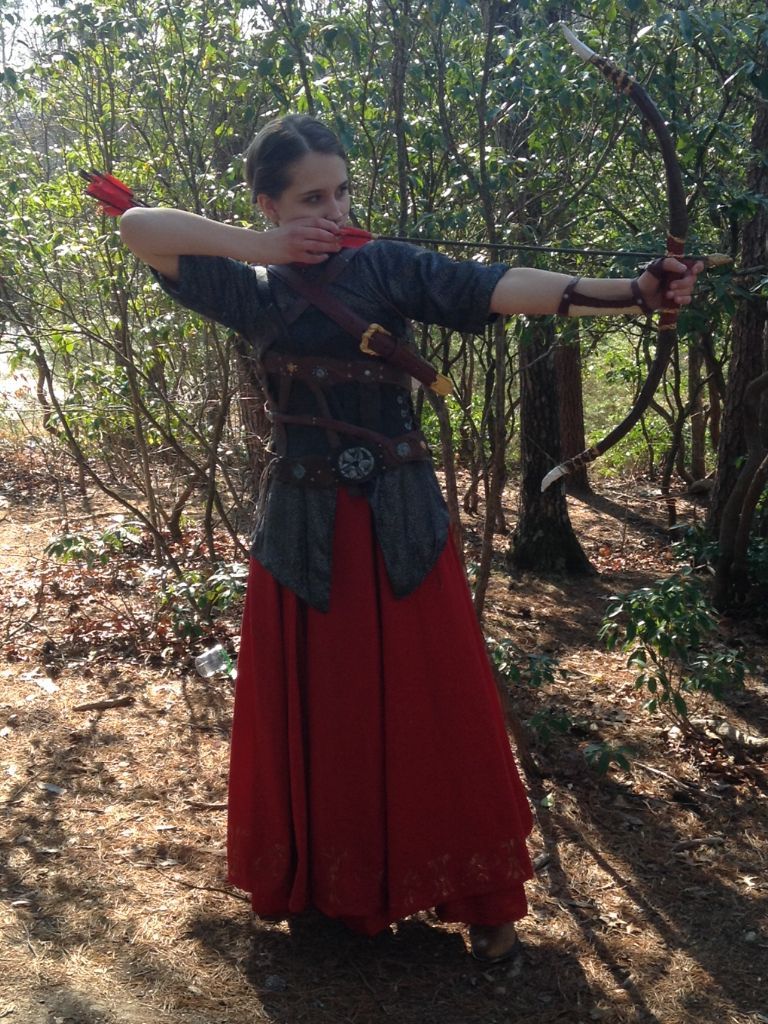
In the Renaissance period, archers typically wore a distinctive outfit consisting of a doublet, belt, and other essential clothing items. As a crucial part of the ensemble, the doublet provided necessary protection and style during that time. Doublets often featured sleeves, a collar, and were made with various materials such as wool, silk, or linen. They were a vital garment for archers, allowing for ease of movement while maintaining a sense of style.
An important accessory to complement the archer’s doublet is the belt. Belts served multiple purposes in Renaissance outfits, such as holding the wearer’s trousers in place or supporting various tools and weapons. For archers, a well-constructed belt was essential for carrying a quiver of arrows and additional supplies. In addition, belts often featured ornate designs and crafted metal buckles, showcasing the wearer’s wealth and taste.
To summarize, a typical Renaissance archer’s outfit would include:
- Doublet: A form-fitting garment with sleeves and a collar, made of materials like wool, silk, or linen.
- Belt: A sturdy accessory for holding trousers and carrying the archer’s equipment. Often adorned with decorative elements.
With these elements combined, we are able to paint a picture of the Renaissance archer’s attire, where both function and style played significant roles.
Stylish Gown
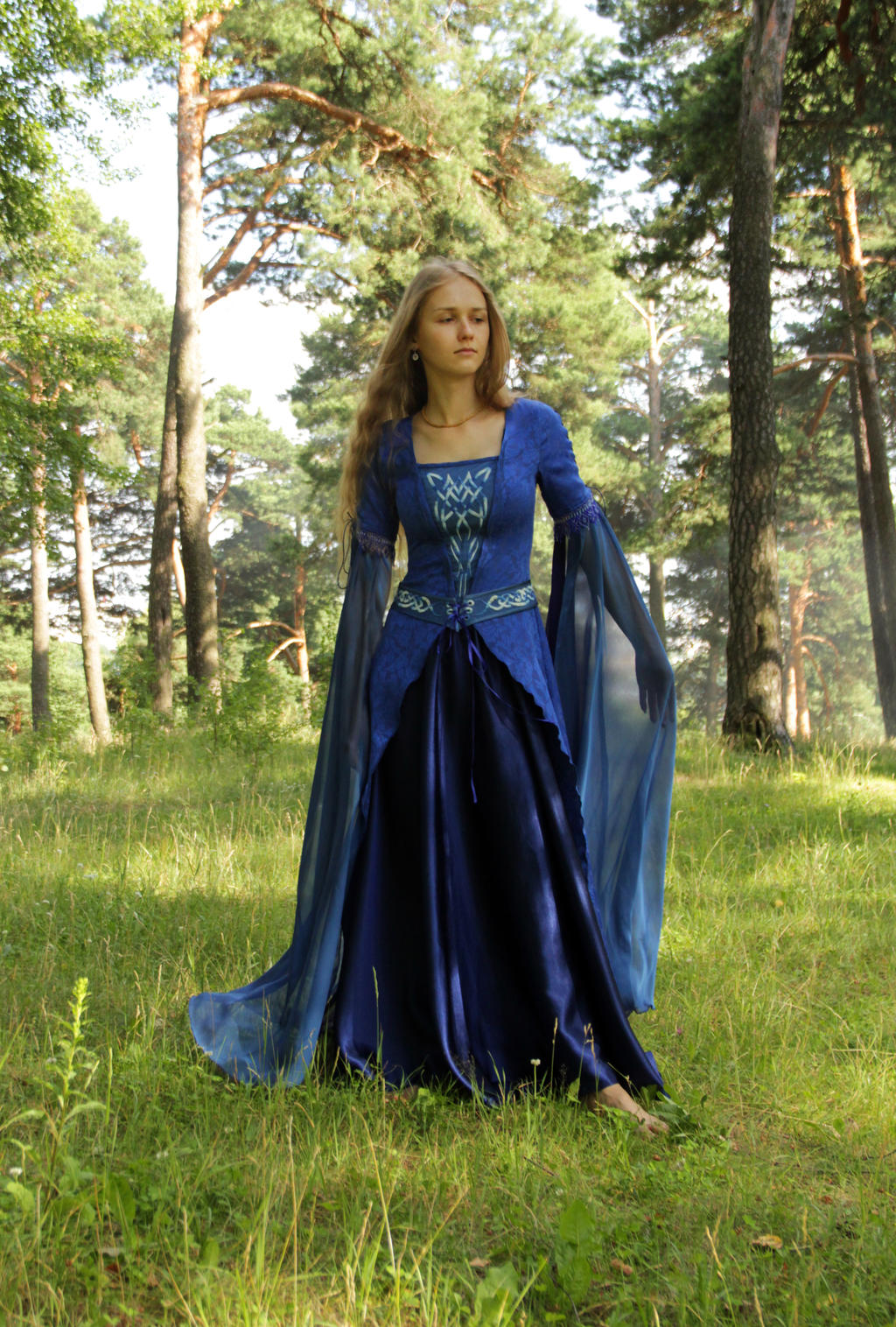
In our exploration of Renaissance outfits, we cannot overlook the elegant and stylish gowns that were a hallmark of this era. Gowns often featured intricate embroidery, luxurious materials, and stunning color combinations crafted from rich fabrics such as velvet, satin, and silk.
Key features of a Renaissance gown:
- Square neckline
- Long, fitted sleeves with puffed upper arms
- Full-length skirt with a voluminous silhouette
- Structured bodice with boning for support
- Intricate embroidery, beadwork, and embellishments
While gowns alone were a statement piece, they were often paired with equally impressive coats. During the Renaissance, coats not only provided warmth but also served as a symbol of status and wealth. Coats were commonly worn over gowns, incorporating materials and designs that complemented the gowns themselves.
Incorporating velvet, brocade, fur, and other luxurious materials demonstrated the wearer’s affluence. As for design, some coats showcased ornate detailing, while others used simple, elegant lines to emphasize the beauty of the underlying gown.
It is important to note that the combination of gowns and coats played a significant role in helping to shape the aesthetic of the Renaissance period. By considering both elements, we gain a richer understanding of the elaborate and carefully crafted outfits from this pivotal time in fashion history.
Warrior Princess
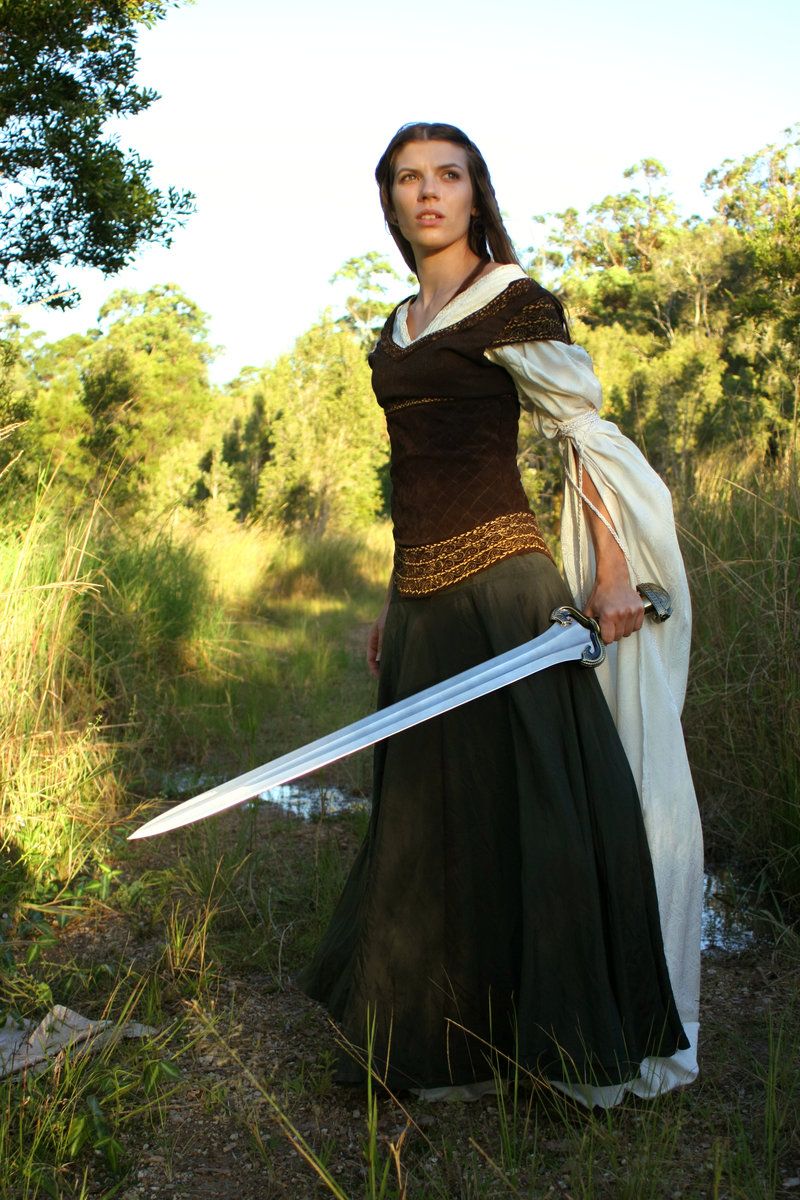
In our exploration of Renaissance outfits, we must not forget the attire of the iconic warrior princess. These powerful and stylish women often combined functionality and fashion in their clothing choices.
One of the essential elements of a warrior princess’s attire would be her sturdy shield. Typically crafted from wood or metal, these shields protected her in battles while also displaying her coat of arms or other decorative designs.
Another essential piece of a warrior princess’s outfit was a pair of durable boots. These boots were often made of high-quality leather and provided excellent support and protection, ideal for standing firm during combat or traversing rugged terrain.
Finally, leather played a significant role in the wardrobe of a Renaissance warrior princess, primarily in the form of armor. Leather armor was lighter than metal alternatives but still offered some protection in battle. Additionally, leather garments, such as tunics and gloves, were not only functional but also fashionable in their time.
So, when envisioning a warrior princess during the Renaissance, we should keep in mind the key elements of shields, boots, and leather, which allowed these impressive females to face their adversaries with confidence and style.
Medieval Archer
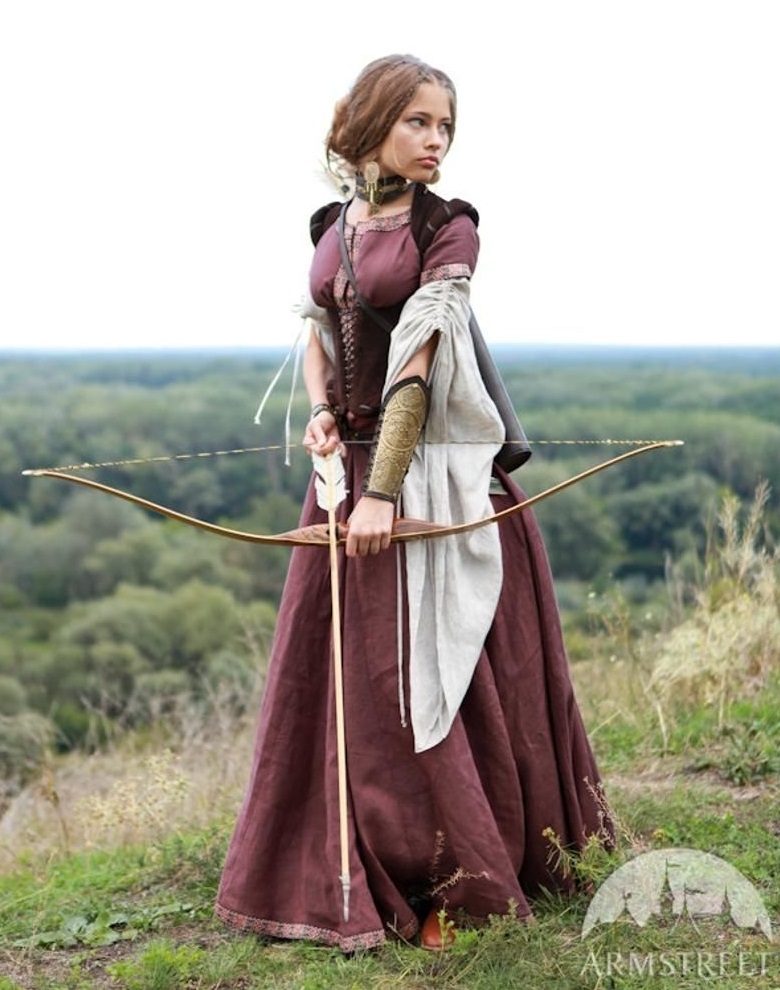
During the Renaissance era, clothing played a significant role in showcasing one’s social status and profession. As experts in Renaissance outfits, we can confidently explain the ensemble typically worn by medieval archers, including the cap, hood, and hats.
Medieval archers usually donned a practical outfit consisting of:
- Cap or Hood: To protect themselves from the elements, archers wore woolen caps or hoods. The hood was often large enough to cover their shoulders and be drawn up over the head for added protection.
- Tunic: A long-sleeved, knee-length garment, made from durable materials like wool or linen, allowed the archers to move freely while offering protection from harsh weather.
- Leggings: Worn under the tunic, these tight-fitting garments provided flexibility and ease of movement during battle.
- Boots: Sturdy leather boots with reinforced soles ensured stability and improved grip on uneven terrains.
Depending on their rank or role in the group, archers might have worn different types of hats or headgear:
- Helmet: Some medieval archers wore helmets, usually made of leather or padded fabric, for added protection during combat situations.
- Chaperon: A popular hat of the time, the chaperon featured a long tail, known as a liripipe, which could be wrapped around the neck or draped over the shoulder for a more fashionable appearance.
- Coif: A close-fitting, linen cap, the coif was sometimes worn underneath the hood or a hat to secure the hair and provide additional warmth.
- Bycocket: A wide-brimmed felt hat, often decorated with a feather or tassel, was also worn by archers to showcase their profession or status.
As experts on Renaissance outfits, we can assure you that medieval archers prioritized practicality and protection in their attire while occasionally displaying their status through fashionable headgear.
